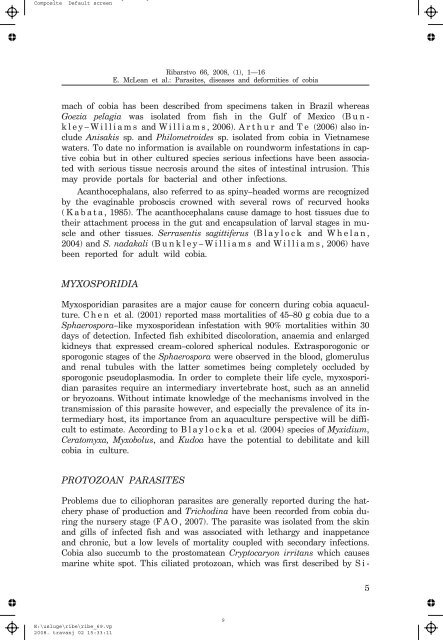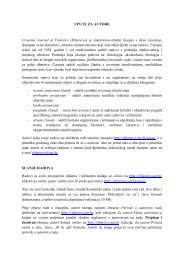PARASITES, DISEASES AND DEFORMITIES OF COBIA
PARASITES, DISEASES AND DEFORMITIES OF COBIA
PARASITES, DISEASES AND DEFORMITIES OF COBIA
Create successful ePaper yourself
Turn your PDF publications into a flip-book with our unique Google optimized e-Paper software.
Composite Default screen<br />
mach of cobia has been described from specimens taken in Brazil whereas<br />
Goezia pelagia was isolated from fish in the Gulf of Mexico (Bunkley–Williams<br />
and Williams, 2006). Arthur and Te (2006) also include<br />
Anisakis sp. and Philometroides sp. isolated from cobia in Vietnamese<br />
waters. To date no information is available on roundworm infestations in captive<br />
cobia but in other cultured species serious infections have been associated<br />
with serious tissue necrosis around the sites of intestinal intrusion. This<br />
may provide portals for bacterial and other infections.<br />
Acanthocephalans, also referred to as spiny–headed worms are recognized<br />
by the evaginable proboscis crowned with several rows of recurved hooks<br />
(Kabata, 1985). The acanthocephalans cause damage to host tissues due to<br />
their attachment process in the gut and encapsulation of larval stages in muscle<br />
and other tissues. Serrasentis sagittiferus (Blaylock and Whelan,<br />
2004) and S. nadakali (Bunkley–Williams and Williams, 2006) have<br />
been reported for adult wild cobia.<br />
MYXOSPORIDIA<br />
Ribarstvo 66, 2008, (1), 1—16<br />
E. McLean et al.: Parasites, diseases and deformities of cobia<br />
Myxosporidian parasites are a major cause for concern during cobia aquaculture.<br />
Chen et al. (2001) reported mass mortalities of 45–80 g cobia due to a<br />
Sphaerospora–like myxosporidean infestation with 90% mortalities within 30<br />
days of detection. Infected fish exhibited discoloration, anaemia and enlarged<br />
kidneys that expressed cream–colored spherical nodules. Extrasporogonic or<br />
sporogonic stages of the Sphaerospora were observed in the blood, glomerulus<br />
and renal tubules with the latter sometimes being completely occluded by<br />
sporogonic pseudoplasmodia. In order to complete their life cycle, myxosporidian<br />
parasites require an intermediary invertebrate host, such as an annelid<br />
or bryozoans. Without intimate knowledge of the mechanisms involved in the<br />
transmission of this parasite however, and especially the prevalence of its intermediary<br />
host, its importance from an aquaculture perspective will be difficult<br />
to estimate. According to Blaylocka et al. (2004) species of Myxidium,<br />
Ceratomyxa, Myxobolus, and Kudoa have the potential to debilitate and kill<br />
cobia in culture.<br />
PROTOZOAN <strong>PARASITES</strong><br />
Problems due to ciliophoran parasites are generally reported during the hatchery<br />
phase of production and Trichodina have been recorded from cobia during<br />
the nursery stage (FAO, 2007). The parasite was isolated from the skin<br />
and gills of infected fish and was associated with lethargy and inappetance<br />
and chronic, but a low levels of mortality coupled with secondary infections.<br />
Cobia also succumb to the prostomatean Cryptocaryon irritans which causes<br />
marine white spot. This ciliated protozoan, which was first described by Si-<br />
E:\usluge\ribe\ribe_69.vp<br />
2008. travanj 02 15:33:11<br />
9<br />
5




